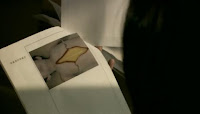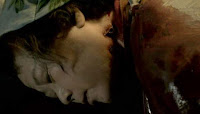Saturday, April 25, 2009
Vamp or Not? The Vanished
Ame no Machi is a 2006 Japanese movie directed by Makoto Tanaka and based on a short story by Hideyuki Kikuchi – the man who wrote 17 Vampire Hunter D novels. Friend and vampire aficionado Leila contacted me and insisted I watched this as she felt it was a definitive ‘Vamp or Not?’ but was still undecided herself.
I can understand the torn feelings she had over this because, as I sit to write this article – having cogitated for some time and even slept on the issue – I am still unsure as to the direction I am going to go. There are definitely vampiric elements but the aim of the film was certainly in other directions. Let us start at the beginning, however.
It is raining (I believe that the Japanese title means Rain Town – but I stand to be corrected) and Mr Uchida, an elderly gentleman, is in his house. We see a picture of a woman, obviously his wife. Suddenly a child is at the door, seen through the glass, calling for his mother and asking to be let in. Uchida picks up the phone and calls someone – he is back, he says. The child is at the window, and although it is difficult to tell through the glass he looks about seven years old. Uchida addresses him as Shin and says that his mother has been dead ten years. The boy becomes more demanding of entrance when a man approaches and puts a cloth sack over his head.
The man drives out into the woods in a truck. He looks nervous as he stops and pulls a crate down that he drags deeper into the trees, off the road. He opens the crate, which at first seems empty to us, and approaches with obvious trepidation; then the boy stands – still wearing the sack. The man whacks him across the head with a cosh and then leans into the crate. He is grabbed and pulled in – obviously indicating some strength.
We see the boy running, his arms outstretched, still wearing the sack. He is pursued by the man, obviously limping. The scene would be darkly funny if it wasn’t so disturbing. They run over a bridge, suddenly the child veers and goes straight through the barrier, falling and impacting heavily on a rock. By the time the man gets there we see blood stains but the body is gone.
Souta is a journalist in Tokyo – we soon discover he works for one of the more obnoxious tabloids. He is interviewing a woman who is clearly a prostitute and who now sells her daughter into prostitution. Her daughter has a little girl herself. By the time he gets back to the office his editor is ready to pull a story as he hasn’t really applied himself. He gives him a new story, ignoring the prostitution one, a child’s body has been found, in a river, all internal organs gone.
We get an insight into how this tabloid works. Souta suggests that fish entered the body, probably through the anus, and ate the organs. He also recognises that the paper wants a story about organ trafficking in Japan – the truth of the situation be damned. He seems burnt out and uninterested, flashbacks show us that the story he was doing on prostitution was personal – he is the son of a prostitute, who then abandoned him.
He heads out of Tokyo and to the hospital were the child’s body is kept. The doctor insists that he does not believe in the supernatural but then completely opens up to Souta – he clearly needs to talk to someone. The doctor believes that the body was fake, the organs are not missing they never were there. He shows him the autopsy report and the inside of the child – in photographs – seems to be just a yellow mass. The Doctor offers to take him to the body.
The boy is laid out on the autopsy table and the doctor asks Souta not to film. He puts his video camera down. Souta is encouraged to touch the boy, his skin has an elasticity when rigor mortis should have set in and the body contained no blood (though blood was left on the rocks earlier). The doctor goes to get the boy's belongings and Souta takes an opportunity to shoot some pictures with his camera phone, of the face, chest and (under the sheet) legs. We notice the boys hand twitching. The belongings were a school uniform for Hinoemura school, with the name badge Shin Uchida. Suddenly the boy sits up and runs from the room.
This leaves the doctor, clearly mad and hiding under a sheet, whilst the seemingly un-phased reporter phones in to the office. He checks his camera and we see that the boy’s feet were deformed. He heads towards Hinoemura, a small village, and stops at the records office of a nearby town. The only Shin Uchida was born in 1962 but he was in a group of 30 children who went missing during a school activity nearly 30 years before. One of the office workers, Fumio, offers to give him a ride.
They stop at a restaurant, where Souta reads a file on the events and eats noodles. The rains start and Fumio suddenly states they have to leave. In the car they talk. We discover that the children of the area are told that to go in the rains as they will cause you to drown – hence her reaction. One child of the thirty was reported found and claimed they had been led off by another group of school children – but no other school had a field trip that day. It is suggested that the other children might have been thought, in times gone by, to be kappa or amanoyjaku devils – I’ll get back to these.
Anyway, the village is nearly empty and I do not want to verbatim go through the film. So I will state that the children, we discover, appear every year with the rains and, if allowed entry, become unruly and uncontrollable – to the point of even killing their parents. Most of the parents have left the village, or are dead, and the village is almost dead itself. As for the children, whilst they appear normal at first – and Souta gains the attention of a young girl named Ayako Takahasi whose parents are gone – they are far from normal.
They seem to change at night – though they can be violent during the day. They make animalistic noises, their eyes become black and bulging and they develop fangs. They seem, at night, to have less control over their violent urges. We also discover that the children can be killed by head trauma. They do seem to need an invitation before they enter someone’s home.
When they attack they seem to primarily go for the neck. We meet the Yasuba family. The man from the beginning, with the sack, is the younger son who was not on the field trip. He is bitten at one point and we see a bandage on his neck with two points of blood soaking through. When the mother is attacked we clearly see fang marks on the neck. This is vampire territory, though whether they are feeding or simply attacking is not revealed.
It was also interesting to note that they seem to crave love. Ayako starts to call Souta brother – one of the frustrating bits was the film doesn’t actually explain whether this is just an affectation to endear herself or whether, given he was abandoned, she actually was his sister and his presence on the case was, therefore, fated. Be that as it may, when he tells her he hates her, her hair goes big (in a demonic way) but she backs away and then – later – tries to make him say he loves her again.
The nocturnal activity, the immortality, the fangs and the neck biting are all prime vampire. The head trauma is part of some vampire stories (as well as other genre lore) and the need for love does sometimes appear in vampire stories. However, clearly, the filmmakers were doing a changeling child film, Japanese style, and I think the mention of Kappa and the amanoyjaku devil is important. Kappa are water spirits, which neatly ties into the rains, and have water filled depressions upon their heads, which when drained can steal their strength, immobilise or kill them depending on the version of the myth. They are known to kidnap children in some stories. The amanoyjaku I assume is an alternate spelling of amanojaku who in (some versions of) the tale Urikohime impersonates the melon daughter by wearing her flayed skin. I am sure aspects of both these traditional creatures were brought into play.
This is, of course, the problem. I do not think the filmmakers intended to bring in a vampiric aspect per se, but there are definitive aspects that fit neatly into the genre. The film itself was a little ponderous in places and there were things around the lead characters I felt were under-explored – especially Souta and Fumio’s relationship. When it came to the kids, however, it consistently hit the spot and, be they changeling children or vampire children, kids at the door demanding entrance and showing fangs are always going to be a winner. It is certainly of interest to the vampire genre fan, however, and I wouldn’t be surprised if this starts hitting vamp filmographies at some point. I am still undecided, but leaning towards this being within the genre. The imdb page is here.
Posted by
Taliesin_ttlg
at
12:04 AM
![]()
Labels: genre interest, vampire
Subscribe to:
Post Comments (Atom)




























2 comments:
What cause all the children to turn into monsters 30 years ago??!
Now that's the mystery
Post a Comment